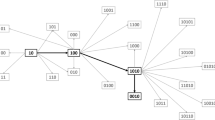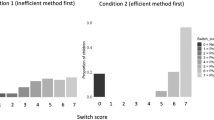Abstract
The remarkable ecological and demographic success of humanity is largely attributed to our capacity for cumulative culture1,2,3. The accumulation of beneficial cultural innovations across generations is puzzling because transmission events are generally imperfect, although there is large variance in fidelity. Events of perfect cultural transmission and innovations should be more frequent in a large population4. As a consequence, a large population size may be a prerequisite for the evolution of cultural complexity4,5, although anthropological studies have produced mixed results6,7,8,9 and empirical evidence is lacking10. Here we use a dual-task computer game to show that cultural evolution strongly depends on population size, as players in larger groups maintained higher cultural complexity. We found that when group size increases, cultural knowledge is less deteriorated, improvements to existing cultural traits are more frequent, and cultural trait diversity is maintained more often. Our results demonstrate how changes in group size can generate both adaptive cultural evolution and maladaptive losses of culturally acquired skills. As humans live in habitats for which they are ill-suited without specific cultural adaptations11,12, it suggests that, in our evolutionary past, group-size reduction may have exposed human societies to significant risks, including societal collapse13.
This is a preview of subscription content, access via your institution
Access options
Subscribe to this journal
Receive 51 print issues and online access
$199.00 per year
only $3.90 per issue
Buy this article
- Purchase on SpringerLink
- Instant access to full article PDF
Prices may be subject to local taxes which are calculated during checkout



Similar content being viewed by others
References
Boyd, R. & Richerson, P. J. Culture and the Evolutionary Process (Univ. of Chicago Press, 1985)
Tomasello, M., Kruger, A. C. & Ratner, H. H. Cultural learning. Behav. Brain Sci. 16, 495–511 (1993)
Boyd, R. & Richerson, P. J. Not by Genes Alone (Univ. of Chicago Press, 2005)
Henrich, J. Demography and cultural evolution: how adaptive cultural processes can produce maladaptive losses: the Tasmanian case. Am. Antiq. 69, 197–214 (2004)
Powell, A., Shennan, S. & Thomas, M. G. Late Pleistocene demography and the appearance of modern human behavior. Science 324, 1298–1301 (2009)
Kline, M. A. & Boyd, R. Population size predicts technological complexity in Oceania. Proc. R. Soc. B 277, 2559–2564 (2010)
Read, D. Population size does not predict artifact complexity: analysis of data from tasmania, arctic hunter-gatherers, and oceania fishing groups. UC Los Angeles: Hum. Complex Systems http://www.escholarship.org/uc/item/61n4303q (2012)
Collard, M., Kemery, M. & Banks, S. Causes of toolkit variation among hunter-gatherers: a test of four competing hypotheses. Can. J. Archaeol. 29, 1–19 (2005)
Read, D. An interaction model for resource implement complexity based on risk and number of annual moves. Am. Antiq. 73, 599–625 (2008)
Caldwell, C. A. & Millen, A. E. Human cumulative culture in the laboratory: effects of (micro) population size. Learn. Behav. 38, 310–318 (2010)
Henrich, J. & Broesch, J. On the nature of cultural transmission networks: evidence from Fijian villages for adaptive learning biases. Phil. Trans. R. Soc. Lond. B 366, 1139–1148 (2011)
Boyd, R., Richerson, P. J. & Henrich, J. The cultural niche: why social learning is essential for human adaptation. Proc. Natl Acad. Sci. USA 108, 10918–10925 (2011)
Diamond, J. The Tasmanians — the longest isolation, the simplest technology. Nature 273, 185–186 (1978)
Boyd, R. & Richerson, P. J. Why does culture increase human adaptability. Ethol. Sociobiol. 16, 125–143 (1995)
Boyd, R. & Richerson, P. J. Why culture is common, but cultural evolution is rare? Proc. Br. Acad. 88, 77–93 (1996)
Tomasello, M. In Social Learning in Animals: the Roots of Culture (eds Heyes, C. M. & Galef, B. G. ) 319–346 (Academic, 1996)
Tennie, C., Call, J. & Tomasello, M. Ratcheting up the ratchet: on the evolution of cumulative culture. Phil. Trans. R. Soc. Lond. B 364, 2405–2415 (2009)
Lewis, H. M. & Laland, K. N. Transmission fidelity is the key to the build-up of cumulative culture. Phil. Trans. R. Soc. Lond. B 367, 2171–2180 (2012)
Dean, L. G., Kendal, R. L., Schapiro, S. J., Thierry, B. & Laland, K. N. Identification of the social and cognitive processes underlying human cumulative culture. Science 335, 1114–1118 (2012)
Derex, M., Godelle, B. & Raymond, M. Social learners require process information to outperform individual learners. Evolution 67, 688–697 (2013)
Claidière, N. & Sperber, D. Imitation explains the propagation, not the stability of animal culture. Proc. R. Soc. B 277, 651–659 (2010)
Diamond, J. Guns, Germs, and Steel: the Fates of Human Societies (W. W. Norton, 1999)
Marquet, P. A. et al. Emergence of social complexity among coastal hunter-gatherers in the Atacama Desert of northern Chile. Proc. Natl Acad. Sci. USA 109, 14754–14760 (2012)
Krause, J., Ruxton, G. D. & Krause, S. Swarm intelligence in animals and humans. Trends Ecol. Evol. 25, 28–34 (2010)
Basalla, G. The Evolution of Technology (Cambridge Univ. Press, 1988)
Henrich, J. & Boyd, R. On modeling cognition and culture: Why cultural evolution does not require replication of representations. J. Cogn. Cult. 2, 87–112 (2002)
Smaldino, P. E. The cultural evolution of emergent group-level traits. Behav. Brain Sci (in the press)
Flynn, E. & Whiten, A. Studying children's social learning experimentally “in the wild”. Learn. Behav. 38, 284–296 (2010)
Acknowledgements
We thank R. Belkhir for help in establishing the Stuctured Qwery Language database, D. Dubois for recruiting participants and organizing the experimental sessions, and the Laboratory of Experimental Economics of Montpellier (University of Montpellier I) for hosting the experiment. Contribution ISEM 2013-146.
Author information
Authors and Affiliations
Contributions
M.D., B.G. and M.R. designed the study. M.-P.B. and M.D. collected data. M.D., M.P.B. and M.R. analysed the data. All authors discussed the results and commented on the manuscript.
Corresponding author
Ethics declarations
Competing interests
The authors declare no competing financial interests.
Extended data figures and tables
Extended Data Figure 1 Cultural tasks.
a, Rectangular grid composed of 35 attaching points in which to draw an arrowhead. The spacing between the attaching points was modifiable. b, An example of an arrowhead. c, Square grid composed of 25 attaching points in which to build a fishing net. The spacing between the attaching points was modifiable. d, An example of a fishing net.
Extended Data Figure 2 Best within-group information associated with the simple task, when conserved within the group.
Performance is measured using arbitrary life units. Plotted are the mean values ± s.e.m. Considering only the performance of the groups that conserved the task (see Methods), the simple task of the cultural package was improved in all group sizes (mean performance: 2-player groups = 2,000, t = 4.90, d.f. = 10, P = 0.0006; 4-player groups = 2,085, t = 11.12, d.f. = 8, P < 0.0001; 8-player groups = 2,166, t = 18.84, d.f. = 11, P < 0.0001; 16-player groups = 2,242, t = 27.57, d.f. = 11, P < 0.0001). Group size had a linear effect on the performance of the best within-group arrowhead (F1,41 = 15.3, P = 0.0003). The horizontal line shows the performance of the arrowhead from the cultural package.
Extended Data Figure 3 Best within-group information associated with the complex task, when conserved within the group.
Performance is measured using arbitrary life units. Plotted are the mean values ± s.e.m. Only 4 2-player groups (26.7%) conserved the complex task and were therefore excluded from the analysis. The complex task was stable in the 4-player groups (mean performance = 2,669, t = 0.01, d.f. = 5, P = 0.99) and improved in the larger groups. The difference between 8-player groups and the demonstration of the cultural package was significant (mean = 4,059, t = 6.79, d.f. = 7, P = 0.0001, one-sided) but marginally significant concerning 16-player groups (mean = 3,108, t = 1.40, d.f. = 9, P = 0.09, one-sided). Group size had a linear and an unexpected quadratic effect on the performance of the best within-group fishing net (F1,24 = 10.6, P = 0.003 and F1,24 = 9.88, P = 0.004, respectively). This quadratic effect could indicate that participants had trouble making use of the information in a large group, but our experimental design allows us to rule out this possibility (see Supplementary Information). Instead, early performances of 16-player groups affected the probability of observing the cultural-package demonstration, hindering players from acquiring pivotal information (see Extended Data Fig. 4 and Supplementary Information). The horizontal line shows the performance of the fishing net from the cultural package.
Extended Data Figure 4 Best within-group information associated with a fishing net (when conserved within the group) across time.
The red line shows 16-player groups and the blue line shows 8-player groups. Performance is measured using arbitrary life units. Plotted are the mean values ± s.e.m. At the beginning of the game, the 16-player groups performed better than the 8-player groups (F1,22 = 21.7, P = 0.0001), as expected. However, the opposite was observed at the end of the game (F1,16 = 5.68, P = 0.03). During the first three trials, the performance associated with the best within-group fishing net affected the probability of observing the cultural-package demonstration. Thus, the probability of observing the cultural-package demonstration was lower in 16-player groups compared with 8-player groups. A lower rate of observation of the cultural-package reduced the group performance suggesting that the observation of demonstrations from other sources hindered the acquisition of pivotal information (see Supplementary Information for details). It suggests that, under specific conditions, the increasing number of valuable sources of information associated with larger group size could lead to a suboptimal cultural evolution rate. The horizontal solid line shows the performance of the fishing net from the cultural package. The horizontal dashed line shows the players’ daily needs.
Supplementary information
Supplementary Information
This file contains Supplementary Results about individual copying fidelity for each of the two tasks and a Supplementary Discussion about the quadratic effect of group size on the complex task improvement. (PDF 149 kb)
Rights and permissions
About this article
Cite this article
Derex, M., Beugin, MP., Godelle, B. et al. Experimental evidence for the influence of group size on cultural complexity. Nature 503, 389–391 (2013). https://doi.org/10.1038/nature12774
Received:
Accepted:
Published:
Issue Date:
DOI: https://doi.org/10.1038/nature12774



